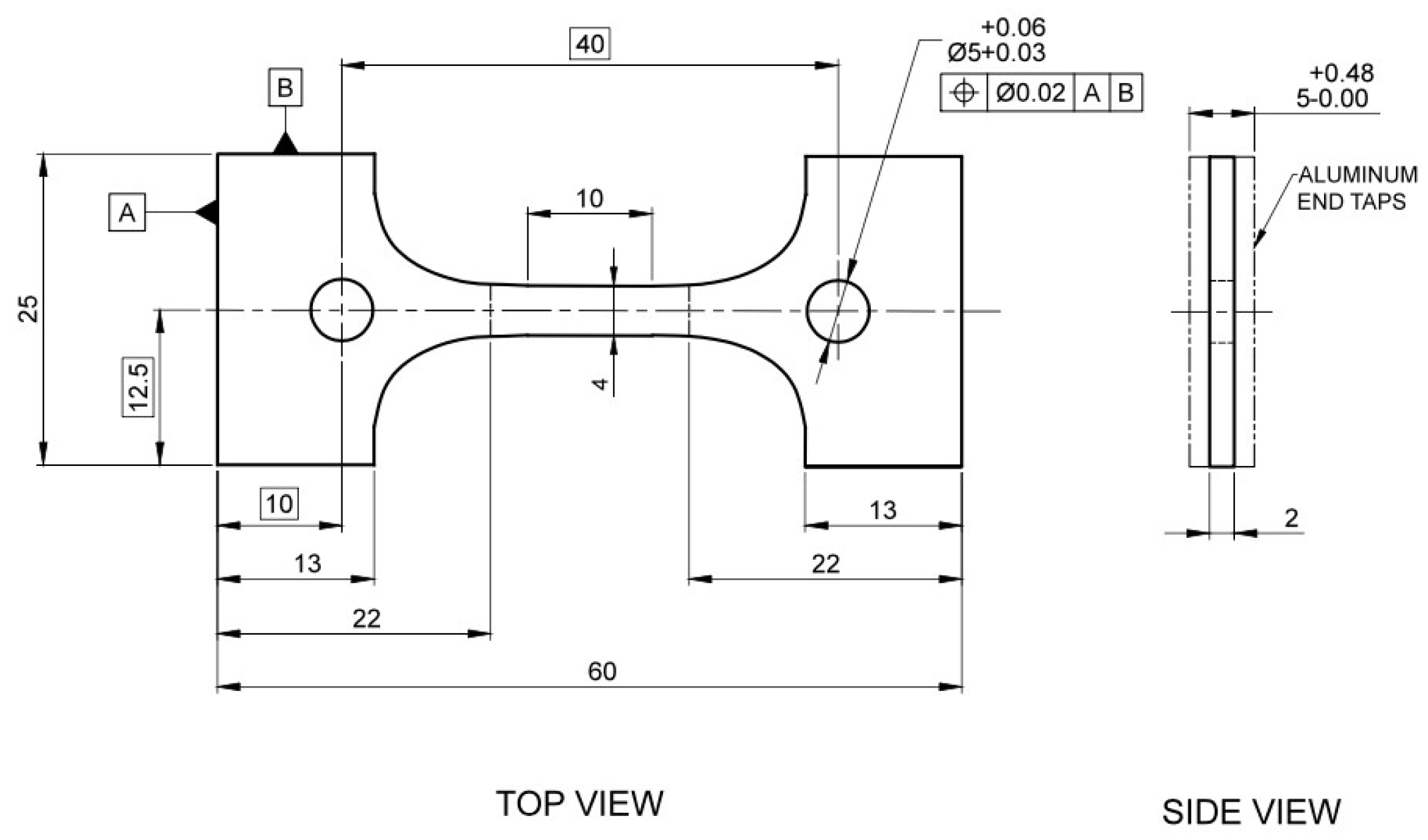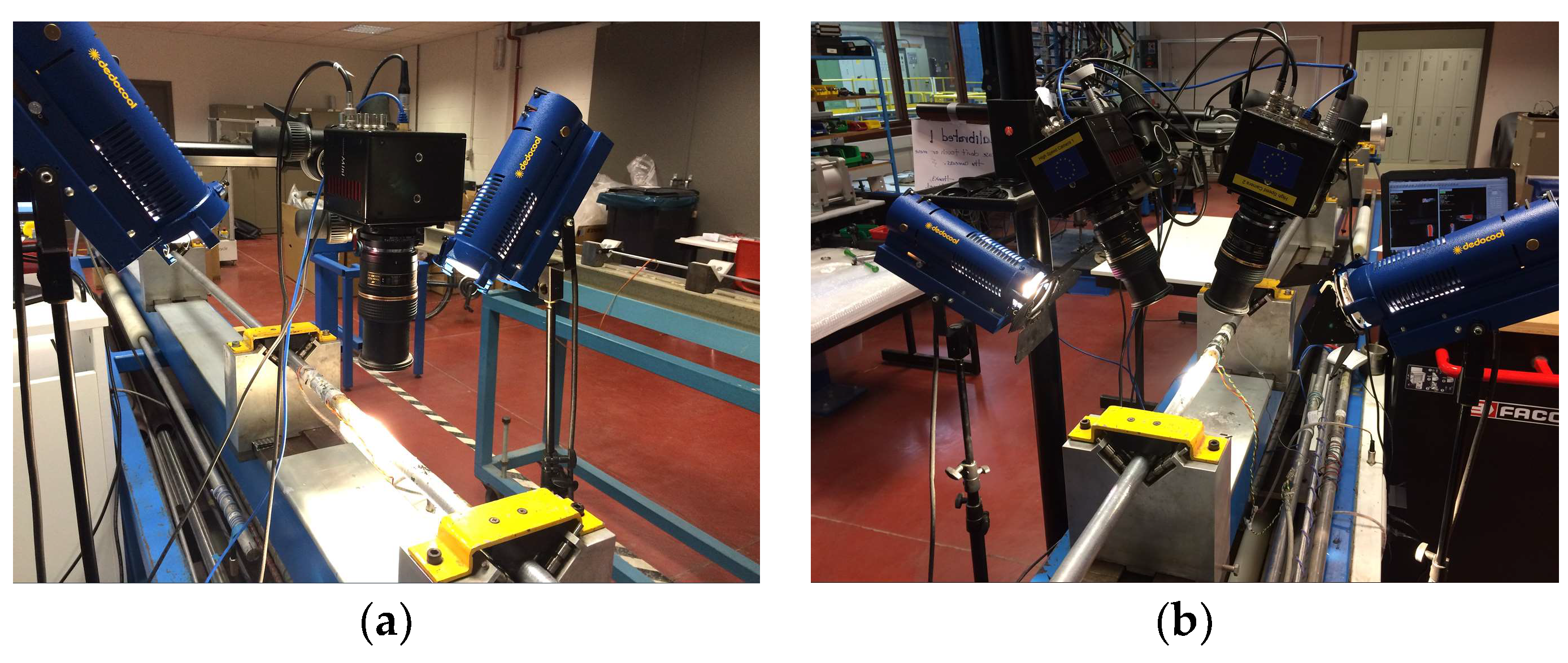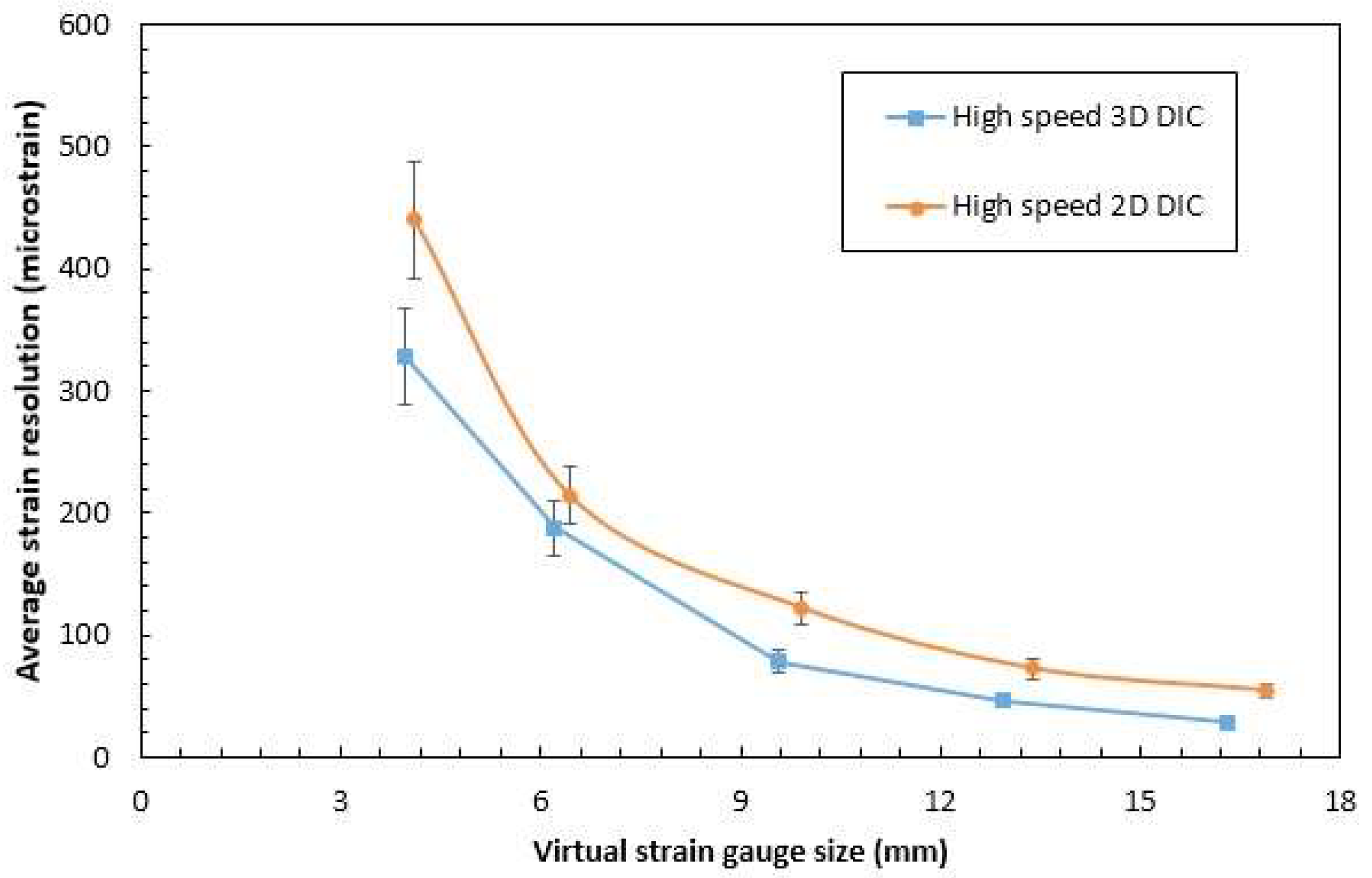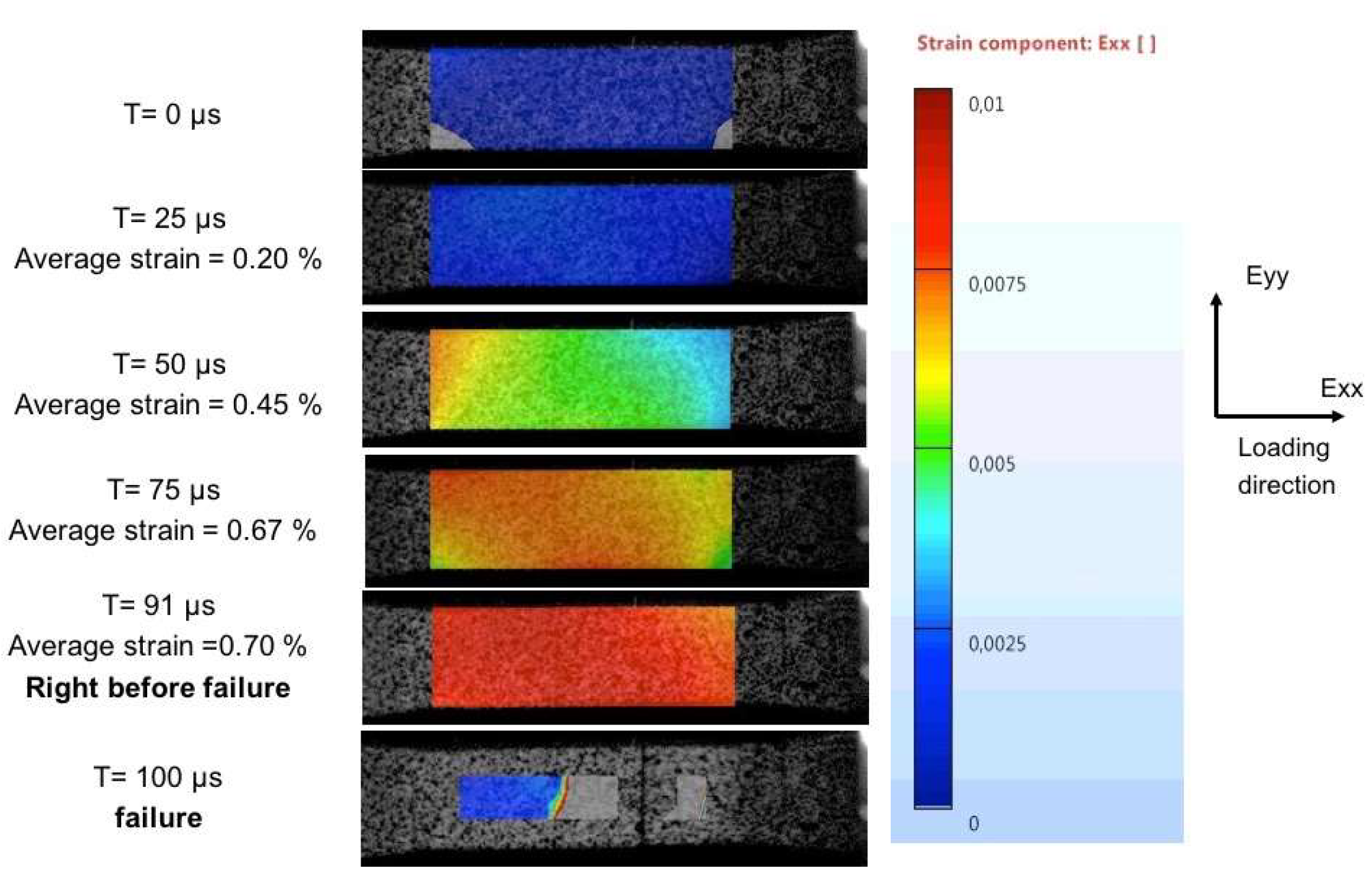The Use of 2D and 3D High-Speed Digital Image Correlation in Full Field Strain Measurements of Composite Materials Subjected to High Strain Rates †
Abstract
:1. Introduction
2. Materials and Methods
2.1. Materials
2.2. Dynamic Testing Setup
2.3. High Speed 2D and 3D DIC Systems
3. Results and Discussion
3.1. Strain Sensitivity
3.2. Full Field Analysis
4. Conclusions
- The high speed 3D DIC technique had lower strain resolution compared to the 2D DIC technique used in this study. This enabled the 3D setup to measure even lower strains compared to the 2D setup.
- The high speed 3D DIC technique used was able to measure the strain localizations in the gauge section around the failure region, while the 2D DIC technique failed to measure these strain concentrations.
Author Contributions
Acknowledgments
Conflicts of Interest
References
- Sharpe, W. Springer Handbook of Experimental Solid Mechanics, 1st ed.; Springer: New York, NY, USA, 2008; p. 931. [Google Scholar]
- Rio, T.G.; Barbero, E.; Zaera, R.; Navarro, C. Dynamic tensile behaviour at low temperature of CFRP using a split Hopkinson pressure bar. Compos. Sci. Technol. 2005, 65, 61–71. [Google Scholar] [CrossRef]
- Verleysen, P.; Degrieck, J. Experimental investigation of the deformation of Hopkinson bar specimens. Int. J. Impact Eng. 2004, 30, 239–253. [Google Scholar] [CrossRef]
- Eskandari, H.; Nemes, J. Dynamic testing of composite laminates with a tensile split Hopkinson bar. J. Compos. Mater. 2000, 34, 260–273. [Google Scholar] [CrossRef]
- Taniguchi, N.; Nishiwaki, T.; Kawada, H. Tensile strength of unidirectional CFRP laminate under high strain rate. Adv. Compos. Mater. 2007, 16, 167–180. [Google Scholar] [CrossRef]
- Kuhn, P.; Ploeckl, M.; Koerber, H. Experimental investigation of the failure envelope of unidirectional carbon-epoxy composite under high strain rate transverse and off-axis tensile loading. EPJ Web Conf. 2015, 94, 01040. [Google Scholar] [CrossRef]
- Koerber, H.; Xavier, J.; Camanho, P.; Essa, Y.; Martín de la Escalera, F. High strain rate behaviour of 5-harness-satin weave fabric carbon–epoxy composite under compression and combined compression–shear loading. Int. J. Solids Struct. 2015, 54, 172–182. [Google Scholar] [CrossRef]
- Gilat, A.; Seidt, J.; Yang, P. Incorporating DIC in high strain rate testing of fibrous composite with the split Hopkinson bar technique. In Proceedings of the 21st International Conference on Composite Materials, Xi’an, China, 20–25 August 2017. [Google Scholar]
- Pankow, M.; Salvi, A.; Waas, A.; Yen, C.; Ghiorse, S. Split Hopkinson pressure bar testing of 3D woven composites. Compos. Sci. Technol. 2011, 71, 1196–1208. [Google Scholar] [CrossRef]
- Lava, P.; Coppieters, S.; Wang, Y.; Van Houtte, P.; Debruyne, D. Error estimation in measuring strain fields with DIC on planar sheet metal specimens with a non-perpendicular camera alignment. Opt. Lasers Eng. 2011, 49, 57–65. [Google Scholar] [CrossRef]
- Sutton, M.; Yan, J.; Tiwari, V.; Schreier, H.; Orteu, J. The effect of out-of-plane motion on 2D and 3D digital image correlation measurements. Opt. Lasers Eng. 2008, 46, 746–757. [Google Scholar] [CrossRef]





| Parameter | Camera 1 | Camera 2 | Stereo Setup |
|---|---|---|---|
| Focal lengths (pixel) | 6471, 6432 | 6773, 6772 | - |
| Distortion coefficient (K1) | 1.163 | 0.2321 | - |
| Optical centers (pixel) | 311.1, 74.88 | 304.8, 232 | - |
| Stereo angles (degree) | - | - | 2.863, 25.58, 0.704 |
| Translation (mm) | - | - | 143.4, 7.096, 43.27 |
| Parameter | Camera 1 |
|---|---|
| Correlation criterion | Zero normalized sum of square differences (ZNSSD) |
| Subset size (pixels) | 31 × 31 |
| Step size (pixels) | 10 |
| Shape function | Affine |
| Prefiltering | Gaussian, kernel size 5 |
| Interpolation | Bicubic spline |
| Strain tensor | Hencky |
| Strain interpolation | Quadratic Quadrilateral |
Publisher’s Note: MDPI stays neutral with regard to jurisdictional claims in published maps and institutional affiliations. |
© 2018 by the authors. Licensee MDPI, Basel, Switzerland. This article is an open access article distributed under the terms and conditions of the Creative Commons Attribution (CC BY) license (https://creativecommons.org/licenses/by/4.0/).
Share and Cite
Elmahdy, A.; Verleysen, P. The Use of 2D and 3D High-Speed Digital Image Correlation in Full Field Strain Measurements of Composite Materials Subjected to High Strain Rates. Proceedings 2018, 2, 538. https://doi.org/10.3390/ICEM18-05439
Elmahdy A, Verleysen P. The Use of 2D and 3D High-Speed Digital Image Correlation in Full Field Strain Measurements of Composite Materials Subjected to High Strain Rates. Proceedings. 2018; 2(8):538. https://doi.org/10.3390/ICEM18-05439
Chicago/Turabian StyleElmahdy, Ahmed, and Patricia Verleysen. 2018. "The Use of 2D and 3D High-Speed Digital Image Correlation in Full Field Strain Measurements of Composite Materials Subjected to High Strain Rates" Proceedings 2, no. 8: 538. https://doi.org/10.3390/ICEM18-05439





